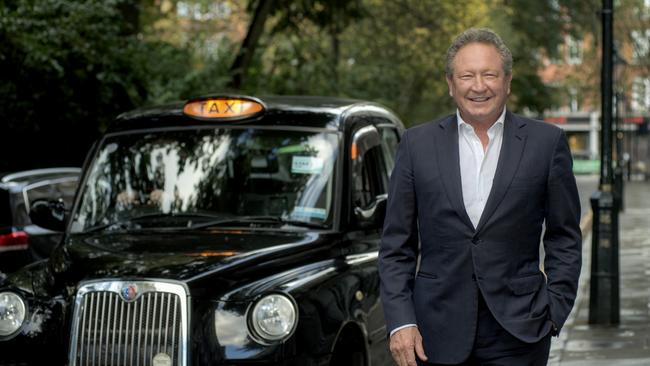‘Fixed it’: Andrew Forrest’s Fortescue hijacks Woodside’s green pitch
Andrew Forrest’s energy upstart has escalated a spat with rival Woodside over its green hydrogen claims.

Andrew Forrest’s energy start-up has defaced an advertisement from rival Woodside Petroleum as a battle exploded over the resources giant’s green credentials on the eve of the pivotal COP26 climate summit.
Woodside released a plan this week to build a huge hydrogen export plant which it claimed would be a net zero carbon dioxide emitter and launched an advertising campaign over the weekend promising it would make a lower carbon future a reality.
The move came as Mr Forrest’s Fortescue Future Industries underlined its green ambitions with a huge deal unveiled on Sunday to become the UK’s largest renewable hydrogen supplier.
The “multi-billion-pound deal” is with construction equipment company JCB, chaired by British billionaire Anthony Bamford and a related transport distribution firm Ryze Hydrogen.
JCB and Ryze will purchase 10 per cent of Fortescue’s global green hydrogen production.
FFI’s green hydrogen production is tipped to grow to 15m tonnes annually by 2030, accelerating to 50m tonnes per year in the decade after.
“This landmark, first of its kind partnership will help the UK to achieve Net Zero, particularly in the hard to electrify sectors,” FFI’s chairman Mr Forrest said.
“Our agreement signals the first major shift in the global commercial landscape from fossil fuels towards the real, practical, implementable solution that is green hydrogen.”
Meanwhile, Fortescue Future Industries, the green energy arm of the iron ore giant, rewrote Woodside’s advertisement on Twitter by crossing out Woodside’s ‘Better Future’ brand and inserting its own name and renewable hydrogen credentials as the better alternative.
“We fixed this for you @WoodsideEnergy,” FFI tweeted. “FACT: Burning blue hydrogen emits more greenhouse gas than burning fossil fuels themselves. Green hydrogen is the solution that the world needs now.”
We fixed this for you @WoodsideEnergy. FACT: Burning blue hydrogen emits more greenhouse gas than burning fossil fuels themselves. Green hydrogen is the solution that the world needs now. #FFI#ThePowerOfNowpic.twitter.com/hKjMKhn4Wk
— Fortescue Future Industries (@FortescueFuture) October 30, 2021
Former Prime Minister Malcolm Turnbull, chairman of FFI’s Australian arm, also weighed into the debate and questioned Woodside’s marketing claims for the WA plant.
“Talk about “economical with the truth” this ad from @WoodsideEnergy claims hydrogen “when used produces no CO2 emissions” BUT fails to say that when made from natural gas produces over 9x as much CO2 as hydrogen. The only clean hydrogen is #GreenHydrogen,” Mr Turnbull tweeted on Saturday after the advertisement appeared.
The spat between the Perth home-town rivals has erupted on the eve of the Glasgow climate summit which Mr Forrest and FFI chief Julie Shuttleworth are attending in person with Woodside’s new chief executive Meg O’Neill tapping into the forum virtually.
Woodside’s green promise has come under attack given about about two-thirds of its proposed WA plant’s output would come from the use of natural gas to produce ammonia at least in the early stages. The Perth producer plans to abate or offset 100 per cent of carbon emissions from the blue hydrogen development.
Fortescue, on the other hand, has proposed a string of hydrogen facilities powered by renewable energy as it looks to pivot into a major clean energy producer in the race to net zero by 2050. Woodside declined to comment on Sunday.
The rivals are also pitched against each other in Tasmania’s Bell Bay industrial precinct. Fortescue is targeting a hydrogen-powered ammonia plant while Woodside is working on the H2TAS project at the same location.
While Mr Forrest slammed both Woodside and Santos as ‘fossils’ in June, saying they had a disgraceful track record on carbon emissions, the billionaire’s critics point out he is also privately funding one of Australia’s biggest gas import plants in NSW and a connected power station that will initially be run on a mix of gas and hydrogen.
Santos escalated a war of words with Mr Forrest last week arguing hydrogen from its Moomba hub will be far cheaper and zero emissions with carbon dioxide reinjected back into the original gas reservoirs underground.
The price of green hydrogen - which taps renewable energy sources to split hydrogen from water which can then be transported as ammonia - is currently much more expensive than hydrogen sourced from gas while shipping is also high cost.
Green hydrogen production is three time the cost of blue hydrogen, although consultancy Wood Mackenzie expects price parity by 2030 and said ultimately both types of the fuel will be needed to hit decarbonisation goals.
Scott Morrison and Energy Minister Angus Taylor announced the “Australian Way” emissions reduction target last week, arguing that the Coalition’s current policies in conjunction with technological growth would be sufficient to reach the mid-century target.
However, Mr Taylor on Sunday declined to outline the ongoing costs of the Coalition‘s net zero 2050 plan, saying governments “don’t commit beyond the next decade”, ahead of the start of the Glasgow meeting.
Canberra has set out a goal for Australia to become a major global hydrogen player by 2030 and a top-three exporter of the fuel to the Asian markets.



